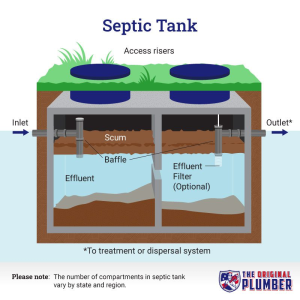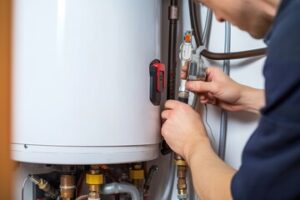When you flush a toilet, take a shower or run the washing machine, wastewater flows into your septic tank. Microorganisms break down the solid waste in the tank, and it settles to the bottom forming sludge. Oil and grease floats to the top as scum. The liquid wastewater, called effluent, exits into a buried drain field or leach field. Click the https://www.septictankarmadale.com.au/ to learn more.

A septic tank is a large, underground storage tank for wastewater from your household toilets, showers, kitchen drains and laundry. Dedicated on-site waste treatment systems, these tanks and absorption fields provide a reliable way to treat and dispose of your household wastewater without the need for public sewer infrastructure.
Solid waste in the form of blackwater (sewage) and greywater from your sinks, showers, washing machines, dishwashers, and clothes washers enters the septic system through a drainage pipe and flows into the tank. During this process, solid wastes sink to the bottom of the tank and form a layer called sludge. Grease and other lightweight materials float to the top of the tank, forming a layer known as scum. Anaerobic bacteria (bacteria that do not require oxygen) in the septic tank break down and decompose these solids and liquids, allowing water to separate from the other waste materials and pass out of the septic system into your drain field.
Over time, septic tanks must be pumped out to remove the sludge that accumulates at the bottom. When this happens, it is important that the sludge not be mixed with the liquid waste in your septic system, as mixing can damage or clog your septic tank and absorption field. The wastewater from your household must also be filtered through the tank’s effluent filter to ensure that any contaminants do not return to your house.
Your septic system’s absorption field, also known as your leach field, or drain field is linked to your septic tank by a pipe that is buried in the ground. A standard leach field has two to five trenches dug into the soil and covered with washed gravel or stone. The trenches are spaced at least 8 feet apart and 3 feet deep, with a 4-inch perforated pipe buried in each trench.
Your septic system’s drain field must be protected from driveways, parking areas, and other impermeable surfaces to avoid excessive water entering the drain field and overwhelming the absorption system. The drain field should also not be used as a children’s playground or for storage purposes, as these can interfere with the proper function of your system. Heavy rainfall, rapid snowmelt, and floods can also prevent your system from working properly by flooding the drain field.
What causes septic tanks to fail?
If your septic tank is failing, it means that it is not treating and disposing of your household waste in the correct way. This can lead to wastewater backups, overflows and even contamination of groundwater. Luckily, there are a few warning signs that you can look for to identify problems before they become serious.
The most common reason that septic tanks fail is that they are full. This is caused by the buildup of biomaterials such as feces, paper and grease. When these materials enter the drain field, they clog lines, soil and distribution boxes.
Another cause of septic tank failure is improper system usage. Things like putting too much food down the garbage disposal or flushing unflushable wipes can cause your septic tank to overflow or become blocked with debris. It is important to be mindful of what you put down the drains so that you don’t risk damaging your septic system or causing a costly breakdown.
It is also important to regularly have your septic tank pumped out. Over time, solids will start to build up in your septic tank and the liquid layer that separates them will disappear. This can result in the septic tank overflowing into your home and can damage your yard and driveway.
If you are concerned about your septic tank, NoCo Septic can help. We provide regular inspections and can help you determine whether your septic tank is in need of repair or replacement. Contact us today to schedule an appointment.
Septic tanks and drain fields can be damaged by heavy rains, flooding, tree roots or tank overloading. When the septic tank is full, it can overflow into the drain field and expose your family to disease-causing bacteria. Other symptoms of a septic system problem include a toilet that refuses to flush and patches of wet, smelly grass near the septic tank or drain field. These problems should be evaluated by a professional as soon as possible. They may require immediate attention to prevent a catastrophic failure of the entire drain field. This can cause sewage to back up into your house and can be a significant health and safety hazard.
How does a septic tank work?
The septic tank is underground, and it receives waste from all the toilets, sinks, and showers in your home. When wastewater leaves your house, it enters the septic tank through drain pipes. Inside the septic tank, there are two chambers separated by a half wall. Solid waste drops into the first chamber, while liquid waste flows over the half wall into the second chamber. In the anaerobic (without oxygen) environment of the septic tank, natural bacteria go to work and break down the solid waste into water and carbon dioxide.
The liquid waste that is left over from the second chamber is called effluent. It passes out of the septic tank through a pipe that leads to your septic system’s absorption field. The septic tank’s outlet baffle directs the effluent down into a network of perforated pipes extending into your septic system’s drain field, where it is further treated through filtration and absorbed into the soil.
Most septic systems rely on gravity to move the wastewater from your home to and from the septic tank and drain field. However, if your tank or drain field is at an elevation higher than your home, it may be necessary to install a pump that can liquefy the wastewater so that it can flow through the septic system.
As wastewater passes through the septic tank, it separates into three layers: The top layer contains grease and other light materials that float above all other waste particles; the middle layer is wastewater; and the bottom layer is sludge. The sludge is heavier than the wastewater, so it settles to the bottom of the tank and the liquid waste moves over the sludge into the discharge pipe.
Keeping the wastewater flowing correctly requires a balance of proper household behavior and maintenance of your septic system. For instance, it is important not to flush or pour chemicals into your septic system that could kill the bacteria that works to break down the wastewater and solid waste. It is also important to maintain the septic tank, and to have it pumped as recommended. In addition, homeowners should map out their septic system and mark locations with permanent stakes or markers so they can avoid damaging the septic tank and distribution box during yard work, landscaping, and construction projects.
What should I do if my septic tank is failing?
A foul odor coming from sinks, toilets, and drains indicates that your septic system is not functioning properly. This smell is caused by gases that are produced by bacteria inside the septic tank as they break down waste. These gases can also be a health risk if inhaled or ingested, so if you notice this issue it is best to call a professional right away.
Slow drainage of your sinks, toilets, and showers is another sign that something is wrong with your septic system. This is because the septic tank is becoming full of solids and restricting wastewater flow. It is important to take care of this issue as soon as possible to avoid a complete system failure.
Finally, if you are seeing sewage spilling into the yard or around the home this is another sign that your septic system is failing. This sewage is untreated and can carry dangerous pathogens. It is important to keep pets and children away from the area to prevent injuries.
Septic systems can be difficult to maintain and many homeowners do not follow the proper steps to ensure that they are working properly. A lack of maintenance is the most common cause of septic system failure. This can include not getting the septic tank pumped on a regular basis. This is important as it keeps the solids from reaching the drainfield and clogging it.
In addition, the use of harsh chemicals in a home can disrupt the balance of bacteria in the septic tank. This can lead to a decreased ability of the bacteria to break down waste and reduce the efficiency of the septic tank.
Additionally, improper installation and site placement can lead to septic system failure. This is because septic tanks must be installed in areas with adequate water table depth and high quality soil to function properly. This type of installation is not suitable for every property, so it is important to have a professional install the appropriate septic system for your home. Septic tanks require routine maintenance and inspections to prevent system failure. If you notice any of the warning signs above, call a professional right away to schedule an appointment to inspect and repair your septic tank.
